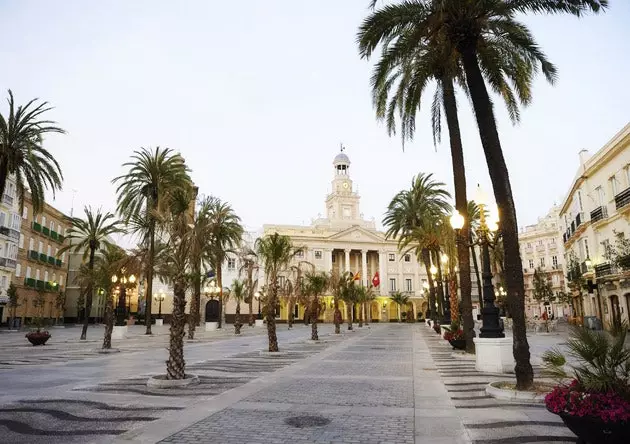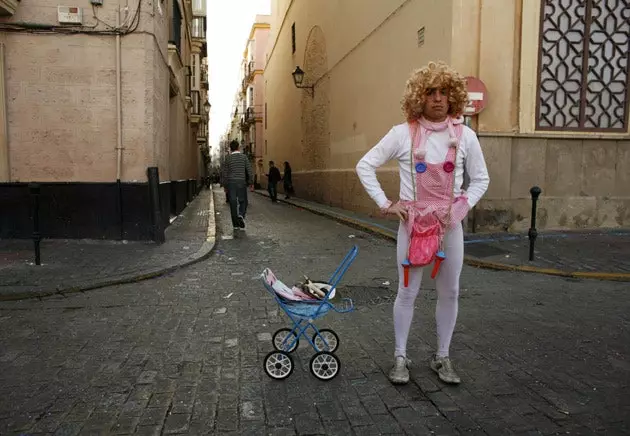
Warning: it will not be that calm
Pick a weekend. Carnival weekends are two plus one tip. The first includes a Friday in which the groups dispute the final at the Falla Theater (this year it falls on February 8) and a Saturday that fills the old part of the city with people in disguise, closer to 20 years of age than to 30, and who basically drinks and hesitates. The following weekend is the time to see the groups on the street, illegal -those that do not participate in the official contest- or not. And there is a third, the carnival of the jartibles (stubborn would be the translation), which brings together almost exclusively Cadiz on Sunday of the following week, with more carnival in the street.
Wear costumes. If you are in Cádiz on February 9 you will feel strange if you are not dressed up. The rest of the days, if you're wearing a costume it's probably because you're going to sing something. While in Tenerife what is popular is to dress up as anything with boobs and in Las Palmas glitter and sequins, in Cádiz it is very well seen to turn into something else what you find at home or in the store of everything at a hundred . And get into the role. It is the right place to dress up as a smurf and smurf the smurf all the smurf.
Sleep. Sleep It is not essential at the Cadiz Carnival, but if you insist, surely you will have to go to El Puerto de Santa María . It is where there are still rooms at a reasonable price (from 80 euros for a double) and it is well connected to the city, especially by ferry on the way out and by taxi on the way back. The little steamer was a ship that had been making that journey since 1929 -that in Cadiz is not that old-, but it sank a couple of years ago on one of the trips it seems that for love of the carnival and to offer the groups a theme to to sing for centuries to come.
Be understood. Contrary to what you might suspect, Cadiz is not a dialect, it is an accent. So there is no manual. Use the context and the hands to find out something. When you've figured it out, get ready for the geographical differential facts here. **Like being told that somewhere is near the bullring (which has not existed for decades) **, being told that they are going to Cádiz when you are in Cádiz (Cádiz or “Cadi, Cadi” is the historical part only ) or that if you ask about the port they send you to El Puerto de Santa María, because here the port for ships is called a dock.
Towers: The best way to get an idea of the city and see them all like little ants in disguise is to climb the tower of the Cathedral. On these dates, the rooftops are filled with clotheslines with costumes in a parallel laundry carnival. If you are lucky and make a friend with a tower, the effect is even better. And if not, try the Torre Tavira, where you can see all of Cádiz in an inverted mirror.
The vineyard. It is the neighborhood where the action is. Same too much. The surrounding streets are a good place to see groups, but you run the risk of getting trapped in a black hole between the shrimp omelettes at El Faro and the Casa Manteca bullfighting tavern, where the typical product is pure art and jokes non stop.
** The new Parador .** This year they have renovated the Parador de Cádiz. As if that were not enough, the views from its terraces of the two forts and the Caleta beach have added a modern air based on glass, wood, marble and steel. It takes you out of the nineteenth-century Cádiz and a little chipped to get into another 21st century that is not bad either. This year you don't come, see if you book now for the next carnival.
The Caleta. Now the ladies are not playing bingo, the summer hallmark of what could well be the most beautiful urban beach in Spain, with the permission of La Concha de Donosti. But the boats are still there. And the sunset between the two forts.

So?
Groupings. To know what the theme of carnival groups is all about, you just have to learn a couplet that came to say that the chirigota is laughter, the comparsa is emotion and the choir is a lot of people . Well, that, you count how many people there are singing and you know what they are. There are also the quartets (made up of between 3 and 5 people, don't ask) and the ballads: a single man who plays the role of the blind people who sang ballads, but with more jokes and less tremendousness.
tablaos. Those who participate in the contest sing in tablaos throughout the city. Get something to snack on, something else to soak it in, and earn Cadiz points by making room for yourself in the crowd to see it up close without elbowing and without having your drink thrown at you.
To eat. Although it is possible that on carnival weekends the king is the sandwich, you can also eat shrimp tortillas, shrimp cones or, if you're in El Puerto and they still make them, the shrimp tortillas in a cone at Ángel León in Aponiente, two in one. The typical of the carnival are the sea urchins and the oysters. They are sold by spontaneous fishermen with stalls located near the bars in the La Viña neighborhood or the market. To check if they are really fresh, you only have to look at whether the guy who opens your hedgehogs is still wearing the diving suit and how much is dripping.
Culture. In your town, popular culture probably consists of bottle nights seasoned with affection for street furniture. In Cádiz the kids get together to rehearse or watch the groups. I have been in the henhouse of the Falla listening to the Selu with a child-juvenile respect I haven't seen since I made my first communion.
Carnival ins and outs. The first step is to understand a little about the lyrics of Carnival. The street groups sell the librettos so that you will be surprised at what goes from what you had understood to what they were singing. And then already, if the vocation comes to you, you can try to expand your knowledge on the internet . On ondacadiz.es and cadiz.es you can follow the performances live daily. And in the forums attend the cakes between followers. Some of the most imbued with Razón are those of comparsista Juan Carlos Aragón, who usually contributes to setting the party on fire a bit before it starts. To get an idea, a few years ago he wrote “Carnival without surnames. A major art for a select rabble ”and this year he publishes“ The nameless carnival. Neither the art is greater, nor the rabble select” in which he retracts based on collejas.
The Selu. In case it had not been completely clear, in Cádiz, carnival is this:
